
Structual
Tollerton Hall, Roclaveston Manor.
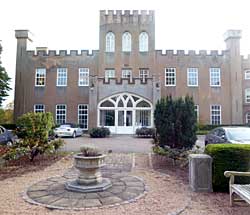
The north front of Tollerton Hall.
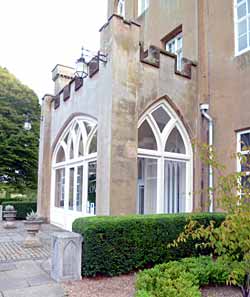
The former porte-cochere.
The present Hall, sometimes referred to as Roclaveston Manor, is the result of much reconstruction in the early part of the nineteenth century when several towers, turrets, pinnacles and battlements imitating Gothic architecture were added. However much of this has now been removed for safety reasons because of stonework decay. The Estate itself has dwindled and in 1980 it occupied about 118 acres of park, woods and arable farm land. According to Whites Directory of 1864 the grounds were extensive and tastefully laid out with shrubs and flowers, with a fine piece of water with a small woody island. Throsby’s picture, dated 1792 show the house (without the Gothic add ons) with the lake in the forefront and a sail boat near to the island. After 1929 the Hall ceased to be a private house and became a residential sports club and hotel. At the onset of World War II it was requisitioned by the government and used by the Army, the RAF and 1100 American paratroopers training for the D-Day landings and later as a prisoner of war camp where German and Italian prisoners were guarded by the Polish Army. By 1946 the Hall was derelict and decaying rapidly but fortunately it was bought on behalf of the Roman Catholic diocese by the Bishop of Nottingham to open a junior seminary where boys might begin their studies for the priesthood. St Hugh’s College as it was to be known as was opened in 1946 by Cardinal Archbishop Griffin of Westminster. It remained a college until 1987 when Bankarts, now part of the Oval group, took it over as their offices.
- Tollerton Hall near Nottingham. A country club in the heart of rural England. No author printed about 1928/9. Local Studies library
- The parish of Tollerton, Nottinghamshire, edited by J K Lees 1980. Manuscripts, University of Nottingham
- List of buildings of special architectural or historic interest, 1986.Manuscripts, University of Nottingham. [sthughscollegetollerton.org.uk/pages/Page_2.html]
St Peters Church
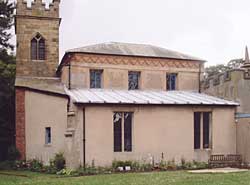
Doomsday Book mentions a Church in Tollerton in the 11th century. There is some debate as to whether there was one previous to this possibly near to the North Manor. The Norman foundations were laid towards the end of the 12th century and the plan was that of the present Church. It contains a nave, chancel, side aisles and tower which once housed the bells which are no longer in use. The Church has been altered during the 19th century by the owners of Tollerton Hall. A Mausoleum for the Pendock Barry family was built which remains to this day. One of the main alterations was a brick extension to the west end which provided a porch, two small vestries and a gallery pew. In the gallery the Barry family sat when attending services. In 1908 the Church was again altered but this time more sympathetically by William Elliott Burnside.
The Parsonage
The parsonage is now a private dwelling house and was sold by the Diocese in November 1975. The original part of the building was built around 1611 and a kitchen was then added in 1625 and consisted of two downstairs rooms and two upstairs rooms. It was later extended to the east in 1697 and a further extension to the east again in 1702 making it a typical Queen Anne house planned on the lines of a wide H, with one central room and two rooms in each wing. The original chestnut staircase was moved to the east side of the house where it remains. Around 1840 the building narrowly escaped being destroyed by fire and two lean-to bedrooms were added. In 1853 the parsonage was valued at £435. The bedrooms were removed in 1918 and replaced with a balcony. The building was used as a military hospital during the Second World War.
- The parish of Tollerton, Nottinghamshire, edited by J K Lees 1980, Local Studies library
- Guide and History to St Peter’s Church. Local studies library
- List of buildings of special architectural or historic interest, 1986. Manuscripts, University of Nottingham.
Farms
-
Hall farm
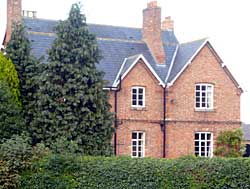
Chestnut Farm. - Chestnut farm
- Manor farm
- Glebe farm
- Russells farm
- Bassingfield farm
The only farm now remaining as a working farm is Glebe farm. All the rest have been sold or converted into dwellings. The main farmhouses have been kept as dwellings and are still in tact. In 2011 the land was contracted out to other farmers for arable farming.
Tollerton Aerodrome – Nottingham Airport
Nottingham has had its own airport for nearly 80 years, dating back to 1928 when the airfield at Tollerton was created by T Shipsides Ltd to serve as the city’s aerodrome. It was leased from Nottingham City Council. Although private flying was in its infancy in the 1930s Tollerton was in demand for this side of air transport. At the onset of the Second World War, all civilian flying was banned and the airfield was taken over by the RAF Rescue School and the National Air Services it became a satellite for RAF Newton. In 1941 the airfield became a training base for Polish airmen.
At the end of hostilities the airfield reverted to private flying but in 1949 the RAF returned to the airfield and used it in conjunction with RAF Syerston. It was decrequistioned by the RAF in 1956 and Sherwood Flying Club took over responsibility for looking after the airfield. It was considered as the place for the East Midlands Airport but was later scrapped. CH Truman and Company Ltd took over the running of the airfield in 1963 and was one of the few devoted exclusively to the needs of private flying and it incorporated the sales and operation of the new American Piper aircraft.
The airfield has continued to be a place for private flying but more recently in 2006 the Nottingham City Council announced it proposed selling the airfield and bids were invited. Coincidentally Rushcliffe Borough Council, the district where the airport is, was being required to build 20,000 new homes and it was felt that this could be a site for 3,000 of them. A new owner was found Nottingham City Airport plc and little has changed at the airfield despite planning applications. However, there is an on-going battle over what the airfield should be used for and the most up-to-date report from the Parish Council is that the site has been identified as a suitable location for an independent hospital.
- Tollerton Village Newsletter November 2001, Tollerton Airport – the early years, Dr Denise M Amos
- Tollerton. An airfield for Nottingham 1929-2007, Howard Fisher, Bob Hammond and Nigel Morley (2008).
- Tollerton Village Newsletter October 2011 Tollerton Parish Council
The Pinfold
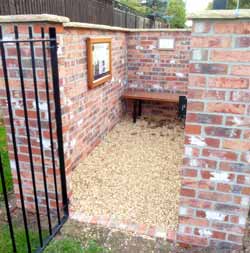
The Pinfold had been situated opposite Chestnut farm for more than a century but was removed when the road to Cotgrave was diverted at the time of Enclosure in 1804. It was rebuilt circa 1830 across the road on Tollerton Lane The cost of which was borne by the old squire who “..gave the workmen such liberal potions that a drunken orgy at the smithy marked the completion of the new building”! It was later demolished in 1966 when the lane was widened. The grassy bank on the west side of Tollerton Lane, in the old village, extending from opposite Bassingfield House to opposite North End Cottages was named Pinfold Bank to remind parishioners of the village Pinfold. More recently it has been rebuilt in its original position opposite Chestnut farm, using reclaimed material in the exact position that the original pre 1804 Pinfold had been, an ambition of John Gadd, late farmer of Chestnut Farm. It was opened on 16 May 2011 with funding from Nottinghamshire County Council Local Improvement Scheme. A set of Stocks stood near to the Pinfold on Tollerton lane and was last recorded in use in 1845 when drunks were tied there to sober up.
War Memorial
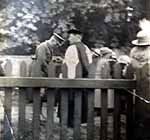 War memorial unveiling in 1919.
War memorial unveiling in 1919.The published list does not show Tollerton having a cross. However in 1919 a War Memorial in the shape of a lantern Cross was erected on the opposite side of the road to the Church. The names of those killed in both World Wars are mentioned on it. There is a plate giving their details at the side of the cross.
North End Cottages
This row of cottages was built between the years 1833 and 1847 by Pendock Barry Barry Esq. of Tollerton Hall and runs at 90 degrees to Tollerton Lane, previously known as Main Street. The cottages originally comprised a block of seven 2-up and 2-down dwellings with a further room to be used as a schoolroom over the archway linking the cottage south of the archway which was to be used as the teacher’s dwelling.
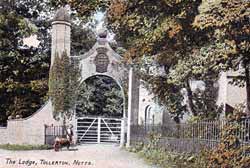
The Lodge c.1905.
The Lodge and attached gateway and wall.
This arched building is found on Cotgrave Lane. It was built c.1824 and was the lodge to Roclaveston Manor. It was later used as the Post Office to the village.
Moated site
There is a moated site north of Cotgrave Lane.